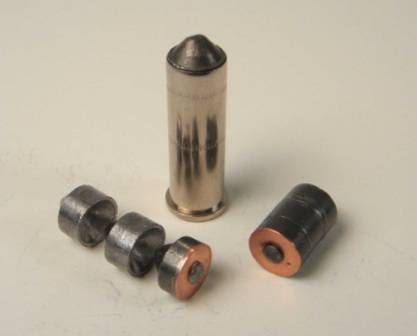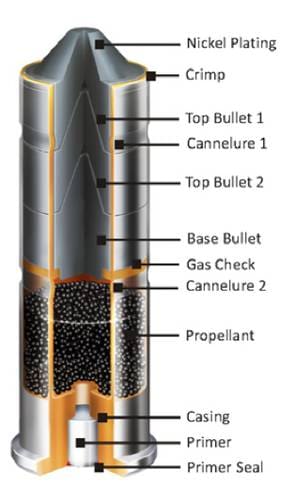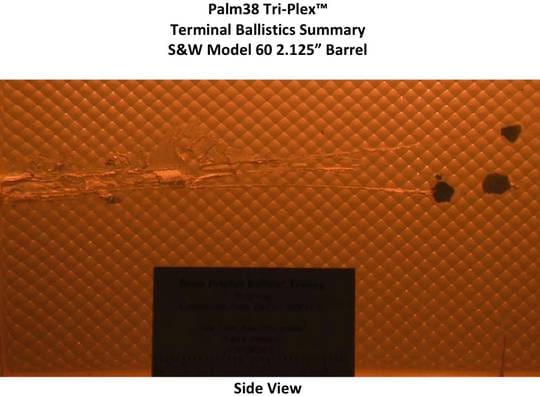Once upon a time a bullet was a projectile inside a casing—and that was pretty much it. These days, it seems like ammo has to emerge from a gun’s muzzle like a circus car revealing a pack of knife-wielding clowns. Or something like that. Or something like this: “Constitution Arms has optimized an ultra low recoil triple‐projectile .38 special standard load cartridge containing two stacked nickel plated conical projectiles and a copper gas checked solid base projectile which, based on testing at close range, delivers a 158 grain payload that reliably separates into two or more penetration tracks and tumbles upon entering tissue.” Cue Boy George’s I’ll Tumble For Ya. Or not. The Tri‐Plex™ bullet producer is serious about creating a round with lower recoil and increased lethality that would suit his Palm Pistol . . .
A total of 13 Tri‐Plex™ were fired and results compared to a popular brand of two 158gr baseline SWC‐HP cartridge test shots at standard and +P loading. Six of these had their projectiles separated into two penetration tracks. These demonstrated a wounding potential similar to the baseline SWC‐HP of comparable loading and velocity with only a 4% smaller hole size.
In the remaining seven instances where complete separation occurred prior to or following impact with the target, the ballistic wound was up to 49% larger (45% avg.) when compared to a baseline expanded standard load SWC HP cartridge, and up to 11% larger (8% avg.) when compared to a baseline expanded +P load SWC‐HP.
Also, at 10 feet distance from the target, both the hit probability and combined surface area of the TriPlex™ were 200% larger than a unitary non expanded projectile of the same caliber.
Findings concluded the Palm38 Tri‐Plex™ ultra low recoil .38 special is capable of delivering incapacitating damage within the recommend maximum engagement distance of 10 feet, and showed considerable promise in terms of increased lethality through an increase in hit probability and kinetic energy transfer from the projectiles.
Beyond 10-feet? Never mind. The question on my mind: what would it take to get someone used to loading their self-defense weapon with traditional bullet to switch over to one of these new, multi-part funky rounds? How do you make that leap of faith when your life depends on unproven (in the field) technology?
Equally interesting: if you shot and killed someone with this or some new bullet technology, could the prosecution use it against you? Look at all the kerfuffle over “cop killer” hollow-points. In a world where governments get their knickers in a twist about magazines that hold more than ten conventional bullets, will we see moves to outlaw these “specialty” rounds?







Ten feet? So, if they’re further away are you supposed to charge them or encourage them to come closer? Or call a time out while you load SWCs?
I like those cable connected rounds better based off just the things I’ve read. I still think a nice JHP is the best though.
Ooh.
Whatever happened with those…T3(?) Rounds?
They were super gimmickey, but kinda cool.
You mean those Bolo shotgun rounds? A 12ga slug cut in half, with 6″ of piano wire connecting the halves?
I wouldn’t want to get hit with that. Or have to clean up after someone else got hit with it.
Enough with the crazy ammo already. Just shoot the bastard between the eyes.
Real hard to do in a reactive situation 😛
Ralph’s on the right track, but if the shoot someone between the eyes with any of my 500’s, they won’t have a head left cuz these babies shoot the nastiest handgun bullets ever made.
HHHHHMMMMMMM….I think I’ll stick with my mix of Magsafe, Glaser Silver Safety Slugs and Extreme Shock Fang Face rounds. An errant one of those hitting an innocent would be a tragedy. What I’d like to know is what happened to the Aguila 9mm IQ (”smart” alloy) rounds?
Good question I love the Aguila IQ ammo. I have carried it in my .45 and 9mm for years. The last I heard it was stopped from importation, It was placed in the cop killer ammo list. I would sure like to fine some more.
do they make it in .40?
Comments are closed.